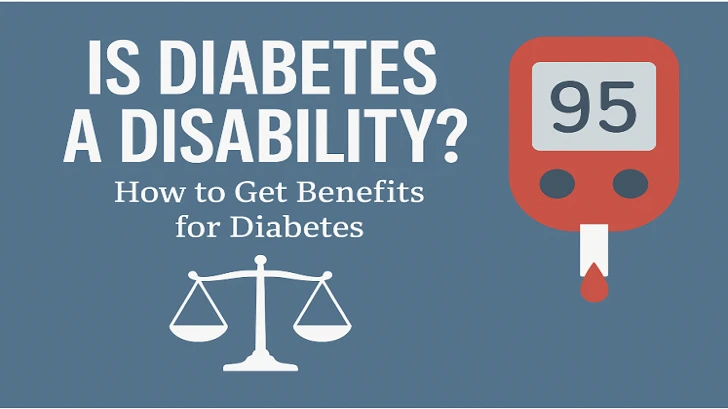- Author: Michael Burry
- Jun 11, 2025
If diabetes is preventing you from doing day-to-day activities, you may be eligible for disability benefits. In the year 2021, nearly 2.1% of disabled workers got approved for the Social Security Disability Benefits for endocrine disorders, including diabetes. For SSA evaluation purposes, diabetes is grouped with other endocrine disorders under the same category.
To help disabled workers get a better idea of whether they may qualify for the benefits, you need to know the eligibility criteria of the SSA for diabetes and how to proceed with the disability claim process.
Is Diabetes A Disability?
Yes, the Social Security Administration considers diabetes a disability when your medical condition prevents you from working. However, some people may continue to work when they have diabetes.
The SSA may not consider your condition as disabling if you continue to work. Under the Americans with Disabilities Act (ADA), people will be protected from discrimination from disabilities.
How Does The Social Security Administration (SSA) Define Diabetes?
As there are two types of diabetes, Type 1 and Type 2 diabetes, the SSA will consider whether you meet the eligibility requirements or not. However, the SSA will also consider other health conditions while considering the benefits.

Common Types Of Diabetes
There are several types of diabetes, including
-
Type 1 diabetes: In type 1 diabetes, there is an absolute deficiency of insulin production. This type, also known as juvenile diabetes, is common in children and young adults. People who are struggling with this type of diabetes may require insulin every day.
-
Type 2 diabetes: Type 2 diabetes results when the body cells resist the action of insulin, which blunts how the body and its metabolism take up glucose. Treatment for type 2 diabetes usually needs a change in lifestyle habits such as physical activity, diet, and increased insulin usage, along with other drugs.
What Are The Symptoms Of Diabetes?
The symptoms of diabetes can vary depending on the type of diabetes and the individual. According to the National Institute of Diabetes and Digestive and Kidney Diseases, some common symptoms associated with diabetes disability are

- Frequent urination
- Excessive thirst
- Weight loss
- Fatigue
- Increased hunger
- Blurred vision
- Reduced visual acuity or loss of peripheral vision
- Slow-healing wounds
- Tingling or numbness
- Recurrent infections
- Dry skin and itching
- Kidney problems
Can You Get Disability Benefits For Diabetes?
Yes, it is possible to qualify for disability benefits for diabetes. If your diabetes makes you unable to do your daily work, you may qualify for work. Diabetes is listed under Section 9 of the SSA Blue Book, where other endocrine disorders are also listed.
How Will I Qualify For Diabetes?
Whenever you apply for diabetes disability, you may be able to prove that you are on insulin and your A1C test results show that it is at least 10% or higher. Furthermore, if your symptoms show that your medical condition is not improving despite medical treatment.
Diabetes is characterized by impaired glucose absorption due to insulin resistance or deficiency, which is a key factor in the disease. If you are experiencing any of the complications mentioned below, your chances of approval may increase:
- Diabetic ketoacidosis (DKA)
- Peripheral neuropathy
- Cerebral edema and seizures
- Cardiac arrhythmias
- Intestinal necrosis
- Hyperglycemia
- Chronic hyperglycemia
- Diabetic nephropathy
- Cardiovascular disease
Working with a doctor for disability may help you document your medical condition who can support your disability application. They may help to prove your diabetes to the SSA. Moreover, you will also be required to submit detailed medical records, diabetes diagnoses, and treatment records.
6 questions to answer before applying for benefits
If your answer to the following questions results in YES, you can qualify for the benefits.
-
Are you insulin-dependent? Without insulin, is your sugar uncontrollable?
-
Are you experiencing neuropathy?
-
Do you have A1C results that indicate 10% or higher?
-
Are your open wounds untreatable?
-
Have you been hospitalized for ketoacidosis?
-
Are you struggling with multiple disabling conditions along with diabetes?
My Diabetes meets the Eligibility Criteria. Now What?
If your diabetes meets the eligibility criteria, the next step is to apply for diabetes disability benefits. Some of the general steps are
-
Gather necessary documentation: Collect all relevant medical records, including doctor’s notes, laboratory test results, treatment history, and any other supporting documents that demonstrate the severity and impact of your diabetes on your ability to work.
-
Review eligibility criteria: Familiarize yourself with the specific eligibility criteria for disability benefits. You would need to meet the requirements set by the Social Security Administration for disability benefits.
-
Complete the application: Fill out the disability benefits application form provided by the relevant government agency, such as the SSA.
-
Submit the application: Submit your completed application and supporting documents to the SSA according to their guidelines. Be sure to keep copies of all documents for your records.
How Much Is a Disability Check For Diabetes?
The average monthly disability check for diabetes and similar endocrine disorders is approximately $1,318.54. However, the amount will vary depending on your work history and income.
In 2024, for Social Security Disability Insurance (SSDI), the maximum amount of benefits is nearly $3,822 every month, and Supplemental Security Income (SSI) benefits per month will be $943. The maximum SSDI and SSI monthly payments are set according to the law and are the same for all disability conditions.
My Diabetes Does not Meet the Eligibility Criteria of the SSA. Now What?
Disabled applicants try to control their diabetes and work. However, qualifying for the benefits may be difficult. Approximately 20% of the applicants get approved at the initial phase of the disability claim.
You can apply for the benefits even if your initial application has been rejected. One of the options is to file an appeal by getting help from a disability lawyer. They are well-versed in the legal system and how to guide you in the best possible way.


